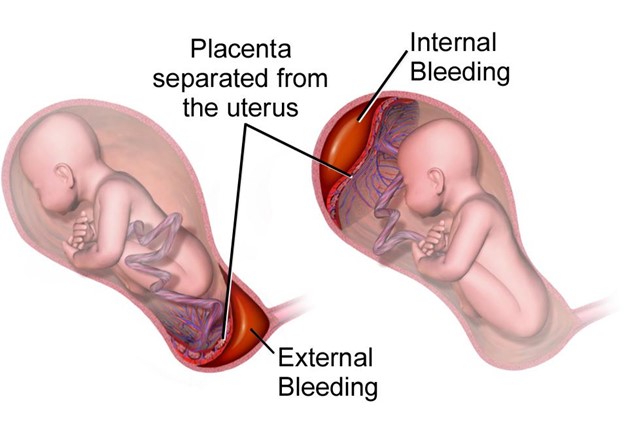A nurse is caring for a client who is at 38 weeks of gestation and is experiencing continuous abdominal pain and vaginal bleeding. The client has a history of cocaine use. The nurse should identify that the client is likely experiencing which of the following complications?
Abruptio placentae.
Hydatidiform mole.
Preterm labor.
Placenta previa.
The Correct Answer is A
Choice A rationale:

Continuous abdominal pain and vaginal bleeding in a client with a history of cocaine use are indicative of abruptio placentae. Abruptio placentae is a medical emergency where the placenta detaches from the uterine wall before delivery, leading to severe bleeding and abdominal pain. Immediate medical intervention is necessary to prevent complications for both the mother and the baby.
Choice B rationale:
Hydatidiform mole is a gestational trophoblastic disease that occurs due to an abnormal pregnancy. It is not associated with continuous abdominal pain and vaginal bleeding. Instead, clients with this condition often present with vaginal bleeding and a grape-like cluster of cysts in the uterus.
Choice C rationale:
Preterm labor involves regular uterine contractions and cervical changes before 37 weeks of gestation. While preterm labor can cause abdominal discomfort, it is not usually described as continuous abdominal pain. Vaginal bleeding is not a typical symptom of preterm labor.
Choice D rationale:
Placenta previa is a condition where the placenta covers the opening of the cervix. It can cause painless vaginal bleeding, but it is not usually associated with continuous abdominal pain. Clients with placenta previa often experience sudden, painless bleeding later in pregnancy.
Nursing Test Bank
Naxlex Comprehensive Predictor Exams
Related Questions
Correct Answer is C
Explanation
Choice A rationale:
Monitoring fluid intake is important for any newborn, but it is not the priority intervention for a small for gestational age (SGA) newborn. SGA infants are at risk of hypoglycemia due to limited glycogen stores, and monitoring blood glucose levels is crucial in identifying and managing hypoglycemia.
Choice B rationale:
Monitoring axillary temperature is essential for all newborns to assess their thermoregulation. However, it is not the priority intervention for an SGA newborn. Hypoglycemia is a more immediate concern and must be addressed promptly.
Choice C rationale:
Monitoring blood glucose levels is the priority intervention for an SGA newborn. As mentioned earlier, SGA infants are at higher risk of hypoglycemia, which can lead to serious complications if not managed appropriately. By monitoring blood glucose levels, the nurse can detect and address hypoglycemia early.
Choice D rationale:
Monitoring weight is important for tracking the growth and development of the newborn, but it is not the priority intervention in this scenario. The immediate concern for an SGA newborn is their blood glucose levels.
Correct Answer is B
Explanation
Choice A rationale:
Restricting protein intake to less than 40 g/day is not appropriate for a client with preeclampsia with severe features. While protein restriction might be advised in some cases of preeclampsia, it is not a priority in severe cases where the focus is on managing potential complications.
Choice B rationale:
Initiating seizure precautions is essential in managing a client with preeclampsia with severe features. Preeclampsia can lead to eclampsia, a condition characterized by seizures. Seizure precautions involve implementing measures to prevent injury during a seizure, such as padding the side rails of the bed, ensuring a clear environment, and having emergency equipment readily available.
Choice C rationale:
Initiating an infusion of 0.9% sodium chloride at 150 ml/hr is not directly related to managing preeclampsia with severe features. Although intravenous fluids may be necessary in some cases, the priority in this situation is to prevent and manage potential seizures.
Choice D rationale:
Encouraging the client to ambulate twice per day is not appropriate for a client with preeclampsia with severe features. Bed rest is often recommended in severe cases to reduce stress on the cardiovascular system and decrease the risk of complications.
Whether you are a student looking to ace your exams or a practicing nurse seeking to enhance your expertise , our nursing education contents will empower you with the confidence and competence to make a difference in the lives of patients and become a respected leader in the healthcare field.
Visit Naxlex, invest in your future and unlock endless possibilities with our unparalleled nursing education contents today
Report Wrong Answer on the Current Question
Do you disagree with the answer? If yes, what is your expected answer? Explain.
Kindly be descriptive with the issue you are facing.
